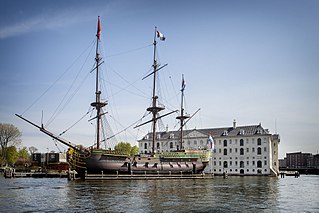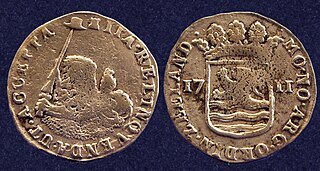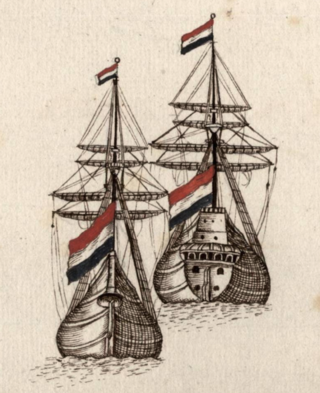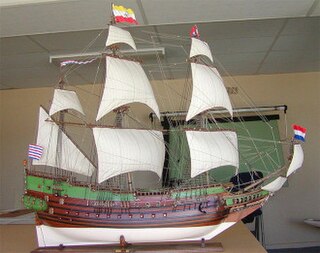Related Research Articles

Batavia ( ) was a ship of the Dutch East India Company (VOC). She was built in Amsterdam in 1628 as the flagship of one of the three annual fleets of company ships and sailed that year on her maiden voyage for Batavia, capital of the Dutch East Indies. On 4 June 1629, Batavia was wrecked on the Houtman Abrolhos, a chain of small islands off the western coast of Australia.

The Amsterdam was an 18th-century cargo ship of the Dutch East India Company. The VOC was established in 1602. The ship started its maiden voyage from Texel to Batavia on 8 January 1749, but was wrecked in a storm on the English Channel on 26 January 1749. The shipwreck was discovered in 1969 in the bay of Bulverhythe, near Hastings on the English south coast, and is sometimes visible during low tides. The location in 1969 was found by Bill Young, the site agent/project manager for the sewage outfall being built by the William Press Group. With time on his hands during the long stay away from home, he followed up the rumour of the going aground. He was castigated by the Museum of London for scooping out the interior of the bow with a digger as it could have led to the structure collapsing. However, it uncovered the initial items which led to a more extensive excavation of the cargo which reflected life at the time. The wreck is a Protected Wreck managed by Historic England. Some of the findings from the site are in The Shipwreck Museum in Hastings. A replica of the ship is on display in Amsterdam.

Zuytdorp, also Zuiddorp was an 18th-century trading ship of the Dutch East India Company.
The Eendracht was an early 17th century Dutch wooden-hulled 700 tonne East Indiaman, launched in 1615 in the service of the Dutch East India Company (VOC). Its Dutch name means "concord", "unity" or "union", and was a common name given to Dutch ships of the period, from the motto of the Republic: Concordia res parvae crescunt . The ship was captained by Dirk Hartog when he made the second recorded landfall by a European on Australian soil, in 1616.
Ridderschap van Holland was a large retourschip, the largest class of merchantmen built by the Dutch East India Company to trade with the East Indies. In 1694 the ship sailed for Batavia on her fifth voyage, but was never heard from again. She is now thought to have been shipwrecked off the west coast of Australia.
The Rooswijk was a ship belonging to the VOC that, according to recent, non-contemporary, news reports, sank in 1740. The wreck is a Protected Wreck managed by Historic England.
The Vergulde Draeck, also spelled Vergulde Draak and Vergulde Draek, was a 41.8-metre (137 ft), 260-tonne (290-ton) ship constructed in 1653 by the Dutch East India Company.

The Zeewijk was an 18th-century East Indiaman of the Dutch East India Company that was shipwrecked at the Houtman Abrolhos, off the coast of Western Australia, on 9 June 1727. The survivors built a second ship, the Sloepie, enabling 82 out of the initial crew of 208 to reach their initial destination of Batavia on 30 April 1728. Since the 19th century many objects were found near the wreck site, which are now in the Western Australian Museum. The shipwreck itself was found in 1968 by divers.
Aagtekerke was a ship of the Dutch East India Company built in 1724. It was lost without trace during its maiden voyage in 1725–26, sailing from Cape of Good Hope in the Dutch Cape Colony to Batavia in the Dutch East Indies.

Leeuwin, was a Dutch galleon that discovered and mapped some of the southwest corner of Australia in March 1622. It was captained by Jan Fransz and was the seventh European ship to sight the continent.
Thirteen ships of the Dutch East India Company and its pre-companies have been named Amsterdam.
Ravesteyn, also written as Ravensteyn, Ravenstein or Ravestein, was an 18th-century East Indiaman of the Dutch East India Company.
The Concordia was a Dutch sailing ship of the Dutch East India Company that left Batavia on 15 January 1708 with two other vessels, Zuiderburg and Mercurius. Concordia had 130 people on board and was bound for the Cape of Good Hope and then the Netherlands. She was last sighted by Mercurius in open seas to the south of the Sunda Strait on 5 February 1708, in bad weather.
The Arnhem or Aernem was a Dutch East Indiaman sailing vessel that was shipwrecked 12 February 1662 off Mauritius on the Saint Brandon Rocks.

Meermin was an 18th-century Dutch cargo ship of the hoeker type, one of many built and owned by the Dutch East India Company. She was laid down in 1759 and fitted out as a slave ship before her maiden voyage in 1761, and her career was cut short by a mutiny of her cargo of Malagasy people. They had been sold to Dutch East India Company officials on Madagascar, to be used as company slaves in its Cape Colony in southern Africa. Half her crew and almost 30 Malagasy lost their lives in the mutiny; the mutineers deliberately allowed the ship to drift aground off Struisbaai, now in South Africa, in March 1766, and she broke up in situ. As of 2013, archaeologists are searching for the Meermin's remains.
The Schoonenberg, also spelled Schonenberg and Schonenbergh, was a trading ship operated by the VOC between 1717 and 1722. The ship, a Spiegelretourschip or Dutch East Indiaman, was damaged beyond repair in an accident at Struisbaai, South Africa on 20 November 1722, during a return voyage to the Netherlands from Batavia, and was later burned and destroyed. This happened on the second of two calamitous voyages; on the maiden sailing in 1720, 75 of the crew died when the ship ran out of water and food on the leg from Cape Town to Ceylon, before finally reaching the diversion port of Mocha after spending 6 months stranded in present-day Somalia.
Three ships of the Dutch East India Company and its pre-companies have been named Leeuwin, including the galleon from which parts of the southwest coastline of Australia were first mapped in March 1622.

Heemskerck was the flagship of Abel Janszoon Tasman's exploratory voyage of 1642. She and her consort Zeehaen were the first European ships to explore the south coast of Australia, including Tasmania, cross the Tasman Sea, and reach New Zealand among other achievements.

The Oosterland was a large 17th-century East Indiaman of the Dutch East India Company. The VOC was established in 1602. The ship was wrecked along with another ship by the ship the Kallendijk on 24 May 1695. The shipwreck was discovered by amateur divers in 1988 on the South African coast a few hundred metres from the entrance to Milnerton Lagoon at the mouth of the Salt River. Excavation of the wreck started in the early 1990s in combination with the University of Cape Town and was led by Bruno Werz.
Valkenbos, also written as Valkenbosch, was an 18th-century fluyt of the Dutch East India Company.
References
- 1 2 "The Dutch East India Company's shipping between the Netherlands and Asia 1595-1795". huygens.knaw.nl. Huygens ING. 2 February 2015. Retrieved 1 February 2020.
- ↑ "Lost VOC Ships at VOC Historical Society" . Retrieved 1 December 2007.
- ↑ "VOC Shipwrecks - Fortuin". Archived from the original on 13 August 2007. Retrieved 1 December 2007.
- ↑ "National Shipwrecks database - Fortuyn" . Retrieved 1 December 2007.